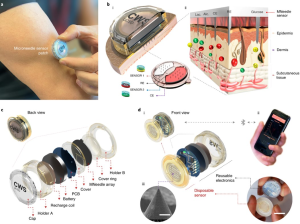An integrated wearable microneedle array for the continuous monitoring of multiple biomarkers in interstitial fluid
Published in Nature Biomedical Engineering.
Authors
Farshad Tehrani, Hazhir Teymourian, Brian Wuerstle, Jonathan Kavner, Ravi Patel, Allison Furmidge, Reza Aghavali, Hamed Hosseini-Toudeshki, Christopher Brown, Fangyu Zhang, Kuldeep Mahato, Zhengxing Li, Abbas Barfidokht, Lu Yin, Paul Warren, Nickey Huang, Zina Patel, Patrick P Mercier, Joseph Wang
Paper presented by Dr. Emily Wires and selected by the NIDA TDI Paper of the Month Committee
Publication Brief Description
As healthcare progresses towards personalized medicine, the development of wearable sensors that measure biomarkers of disease is essential for making an early diagnosis and monitoring therapeutic efficacy. In this TDI Paper of the Month, Tehrani et al, describes the development and implementation of a wearable sensor that contains an array of microneedles for real-time monitoring of lactate and glucose or alcohol and glucose from interstitial fluid. This device uses reusable electronics, a disposable microneedle array and continuously collects data that can be recorded and visualized using a smartphone app. Participants were asked to complete multi-event activities such as exercise, meal consumption, and alcohol consumption. The system provided continuous, quantitative real-time data during each event. This paper highlights an emerging technology pertaining to wearable sensors and shows the potential for garnering clinical data from individuals with alcohol abuse disorder, liver disease, and metabolic diseases.
An integrated wearable microneedle array for the continuous monitoring of multiple biomarkers in interstitial fluid Journal Article
In: Nat Biomed Eng, 2022, ISSN: 2157-846X.

